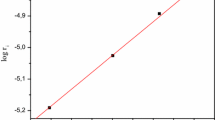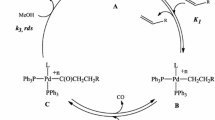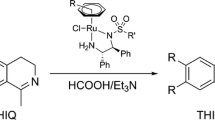Abstract
The system prepared in situ by addition of two equivalents of 1,2-bis(diphenylphosphino)ethane (dppe) to Rh2Cl2(COE)4 (COE = cyclooctene) showed to be an efficient and regioselective precatalyst for the hydrogenation of quinoline (Q). This reaction showed to be independent of the Q concentration and of fractional order on H2 and catalyst concentrations (1.5 and 0.6, respectively). The fractional order on catalyst concentration indicates that several catalytic species with different activities are present in the reaction medium; however, the cationic species [Rh (dppe)2]+ was the only phosphorous-containing compound detected by 31P{1H} NMR. For the acac salt of this cationic bis(dppe) complex, a kinetic study led to the rate law r = {K1k2/(1 + K1[H2])}[M][H2]2; [M(Q)(κ2-dppe)(κ1-dppe)]+ was proposed as the catalytically active species (CAS) of the cycle. The general mechanism involves a reversible oxidative addition of H2 to generate a dihydrido complex, which transfers the hydride ligands to the coordinated Q to yield species containing a 1,2-dihydroquinoline (DHQ) ligand, followed by a second oxidative addition of H2, considered as the rate-determining step of the cycle; hydrogen transfer toward the DHQ ligand yields THQ, regenerates the CAS and restarts the catalytic cycle.
Graphical Abstract
The system prepared in situ by addition of two equivalents of 1,2-bis(diphenylphosphino)ethane (dppe) to Rh2Cl2(COE)4 (COE = cyclooctene) showed to be an efficient and regioselective precatalyst for the hydrogenation of quinoline (Q). This reaction proceeds through several catalytic species with different activities; the cationic species [Rh (dppe)2]+ was the only phosphorous compound detected by 31P{1H} NMR. For the acac salt of this cationic bis(dppe) complex, a kinetic study lead to the rate law r = {K1k2/(1 + K1[H2])}[M][H2]2; [M(Q)(κ2-dppe)(κ1-dppe)]+ was proposed as the catalytically active species (CAS) of the cycle. The general mechanism involves a reversible oxidative addition of H2 to generate a dihydrido complex, which transfer the hydride ligands to the coordinated Q to yield species containing a 1,2-dihydroquinoline (DHQ) ligand, followed by a second oxidative addition of H2, considered as the rate-determining step of the cycle; hydrogen transfer toward the DHQ ligand yield THQ, regenerates the CAS and restarts the catalytic cycle.




Similar content being viewed by others
References
Topsøe H, Clausen BS, Massoth FE (1996) Hydrotreating catalysis. Springer, Berlin
Sánchez-Delgado RA (2000) In: James BR, van Leeuwen PWNM (eds) Organometallic modelling of the hydrodesulfurization and hydrodenitrogenation reactions. Kluwer, Dordrecht
Fish RH, Michaels JN, Moore RS, Heinemann H (1990) J Catal 123:74
Fish RH, Tan JL, Thormodsen AD (1984) J Org Chem 49:4500
Fish RH, Kim HS, Babin JE, Adams RD (1988) Organometallics 7:2250
Baralt E, Smith SJ, Hurwitz J, Horváth IT, Fish RH (1992) J Am Chem Soc 114:5187
Sánchez-Delgado RA, González E (1989) Polyhedron 8:1431
Sánchez-Delgado RA, Rondón D, Andriollo A, Herrera V, Martín G, Chaudret B (1993) Organometallics 12:4291
Chin CS, Park Y, Lee B (1995) Catal Lett 31:239
Rosales M, Alvarado Y, Boves M, Rubio R, Sánchez-Delgado R, Soscún H (1995) Transition Met Chem 20:246
Rosales M, Castillo J, González A, González L, Molina K, Navarro J, Pacheco I (2004) Transition Met Chem 29:221
Alvarado Y, Busolo M, López-Linares F (1999) J Mol Catal 142:163
Rosales M, Vallejo R, Soto JJ, Chacón G, González A, González B (2006) Catal Lett 106:101
Rosales M, Vallejo R, Bastidas LJ, González B, González A (2007) React Kinet Catal Lett 92:99
Borowski AF, Sabo-Etienne S, Donnadieu B, Chaudret B (2003) Organometallics 22:1630
Rosales M, Vallejo R, Soto JJ, Bastidas LJ, Molina K, Baricelli P (2010) Catal Lett 134:56
Herde JL, Lambert JC, Senoff CV (1974) Inorg Synth 15:18
Varshavskii YS, Cherkasova TG (1967) Russ J Inorg Chem (English Transl) 12:899
Casado J, López-Quintela MA, Lorenzo-Barral FM (1986) J Chem Ed 63:450
C L Young (ed) (1981) Solubility data series, vol 5/6, 420. Pergamon, Oxford, p 176
Crabtree RH, Anton DR (1983) Organometallics 2:855
James BR, Mahajan D (1979) Can J Chem 57:180
Rosales M, González A, González B, Moratinos C, Pérez H, Urdaneta J, Sánchez-Delgado R (2005) J Organomet Chem 690:3095
Kiss G (2001) Chem Rev 101:3435
S. Yoshida, Y. Ohomori, Y. Watanabe (1988) J Chem Soc Dalton Trans 895
Allen K, Bruck M, Gray S, Kingsborough R, Smith D, Weller K, Wigley D (1995) Polyhedron 14:3315
Rosales M, Boves M, Soscún H, Ruette F (1998) J Mol Struct (Theochem) 433:319.H
Stark GA, Arif AM, Gladysz JA (1994) Organometallics 13:4523
Acknowledgment
Financial supports from Consejo de Desarrollo Científico y Humanístico of the Universidad del Zulia (CONDES-L.U.Z.) for Project CONDES-0040-2009 are gratefully acknowledged.
Author information
Authors and Affiliations
Corresponding author
Rights and permissions
About this article
Cite this article
Rosales, M., Bastidas, L.J., González, B. et al. Kinetics and Mechanisms of Homogeneous Catalytic Reactions. Part 11. Regioselective Hydrogenation of Quinoline Catalyzed by Rhodium Systems Containing 1,2-Bis(diphenylphosphino)ethane. Catal Lett 141, 1305–1310 (2011). https://doi.org/10.1007/s10562-011-0641-z
Received:
Accepted:
Published:
Issue Date:
DOI: https://doi.org/10.1007/s10562-011-0641-z




